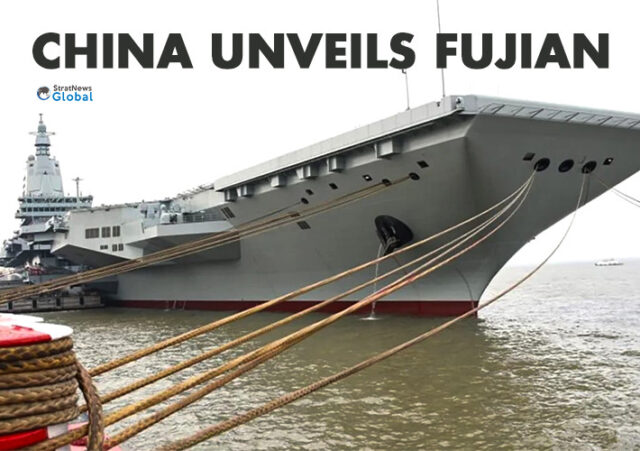China’s third aircraft carrier the 80,000-ton Fujian, left the Shanghai Jiangnan Shipyard to begin the first round of sea trials in the East China Sea, around 160 km from the shipyard. These trials will test the ship’s engines and electrical systems. The vessel has been undergoing tests at the dock after being formally launched in 2022. Chinese media reports said it had completed mooring trials and all outfitting work and equipment adjustments.
The third aircraft carrier for the Chinese Navy follows the first two, the Liaoning and the Shandong. But Fujian has been entirely designed and built in China, and takes the name of the southeastern province. It features a full flat 250-feet long flight deck with EMALS (Electro-Magnetic Aircraft Launch System), a first for the navy. It is powered by steam turbines comprising eight boilers and four shafts generating around 200,000 horse power.
It can carry 50 aircraft of all kinds including 24 J-15 fighters, that are twin-engined all weather aircraft; 12 J-35s, that are also twin-engined with the RD-93 acquired from Russia, helicopters and reconnaissance aircraft.
The ship took nearly six years to build with prefabricated block modules being moved to the dry dock from the factory.
The Fujian dwarfs the Chinese Navy’s two other carriers, the 60,000-ton Liaoning and the 66,000-ton Shandong. Only the US Navy operates bigger carriers. Also, while the Liaoning and Shandong have a ski-jump that facilitate aircraft take off, the Fujian with its EMALS can launch heavier aircraft carrying heavier ordnance and other payloads over longer distances.
It marks a significant enhancement of the Chinese Navy’s blue water capabilities, say various media reports. The EMALS puts it at par with the USS Gerald Ford which also operates an EMALS.
But US carriers are nuclear-powered, making them bigger and more powerful. They can stay at sea longer, unlike the Fujian which has to dock somewhere to take on fuel.
Thirty eight years in journalism, widely travelled, history buff with a preference for Old Monk Rum. Current interest/focus spans China, Technology and Trade. Recent reads: Steven Colls Directorate S and Alexander Frater's Chasing the Monsoon. Netflix/Prime video junkie. Loves animal videos on Facebook. Reluctant tweeter.





